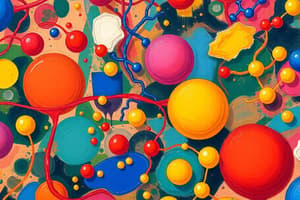Podcast
Questions and Answers
Which process describes the synthesis of proteins from amino acids?
Which process describes the synthesis of proteins from amino acids?
- Anabolism (correct)
- Digestion
- Hydrolysis
- Catabolism
Minerals are organic compounds that contain carbon chains and are essential for various bodily functions.
Minerals are organic compounds that contain carbon chains and are essential for various bodily functions.
False (B)
What type of bond is formed when two amino acids join together, and what molecule is released in the process?
What type of bond is formed when two amino acids join together, and what molecule is released in the process?
peptide; water
A __________ is a molecule composed of glycerol and three fatty acids, commonly found as stored fat in the body.
A __________ is a molecule composed of glycerol and three fatty acids, commonly found as stored fat in the body.
Match the following organic molecules with their building blocks:
Match the following organic molecules with their building blocks:
Which of the following best describes the role of vitamins in the body?
Which of the following best describes the role of vitamins in the body?
Digestion is an example of an anabolic process because it involves breaking down large molecules into smaller units.
Digestion is an example of an anabolic process because it involves breaking down large molecules into smaller units.
If a molecule contains carbon, hydrogen, and oxygen in a specific ratio and is a simple sugar unit, which type of organic molecule is it most likely to be?
If a molecule contains carbon, hydrogen, and oxygen in a specific ratio and is a simple sugar unit, which type of organic molecule is it most likely to be?
Flashcards
Metabolism
Metabolism
Sum of all chemical reactions occurring within the body's cells.
Catabolism
Catabolism
Breaking down larger molecules into smaller units, releasing energy.
Anabolism
Anabolism
Building smaller units into larger molecules, requiring energy.
Nutrient
Nutrient
Signup and view all the flashcards
Organic molecule
Organic molecule
Signup and view all the flashcards
Carbohydrate
Carbohydrate
Signup and view all the flashcards
Lipid
Lipid
Signup and view all the flashcards
Proteins
Proteins
Signup and view all the flashcards
Study Notes
- Metabolism is the sum of all chemical reactions occurring within the body's cells.
- Catabolism involves breaking down larger molecules into smaller units, releasing energy, like in digestion.
- Anabolism involves building smaller units into larger molecules, requiring energy, such as in protein synthesis.
- Nutrients are substances in food that support growth, repair, and body maintenance, including water, carbohydrates, lipids, proteins, minerals, and vitamins.
- Organic molecules are large molecules containing a carbon chain, including carbohydrates, lipids, proteins, nucleic acids, and vitamins.
Carbohydrates
- Contain carbon, hydrogen, and oxygen.
- Monosaccharides are simple sugars like glucose, fructose, and galactose.
- Disaccharides consist of two simple sugars joined together, such as sucrose, maltose, and lactose.
- Polysaccharides consist of many simple sugars joined to form larger molecules like glycogen, cellulose, and starch.
Lipids
- Consist of one glycerol molecule and one, two, or three fatty acids and store energy.
- Triglycerides are the most common type of fat, including fat stored in the body, and consist of glycerol and three fatty acids.
Proteins
- Organic compounds are made of many amino acids.
- A peptide bond forms when amino acids bond together releasing a water molecule.
- A dipeptide consists of two amino acids bonded together.
- A polypeptide consists of 3-10 amino acids bonded together.
- Proteins are involved in all chemical reactions.
Vitamins
- Organic compounds are involved in immune defense, healing, and tissue health.
- Vitamins are cofactors for enzyme function.
- Inorganic compounds do not contain a carbon chain nor carbon.
Minerals
- Include substances, such as calcium, phosphorus, and magnesium, which are required in small quantities in the diet.
- Minerals are components of hormones and enzymes, are important for bone, muscle, and nerve function, and regulate water balance.
Studying That Suits You
Use AI to generate personalized quizzes and flashcards to suit your learning preferences.
Related Documents
Description
Overview of metabolism, covering catabolism (breakdown) and anabolism (synthesis). Discussion of nutrients, including organic molecules like carbohydrates and lipids. Carbohydrate types (monosaccharides, disaccharides, polysaccharides) and lipid composition are examined.



